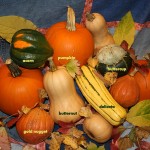 By Getty Stewart, Professional Home Economist
By Getty Stewart, Professional Home Economist
Every autumn the most famous representative of the squash family, the pumpkin, is dressed up and put out on stoops throughout North America. It is a symbol of autumn, Thanksgiving and of course Halloween. But giant carved pumpkins provide only a brief glimpse into the wide world of nutritious, delicious, low cost and versatile winter squash.
Winter squash come in a variety of shapes and sizes. They all have a tough outer rind that surrounds sweet yellow to deep orange flesh and a seed pocket. The flesh may be fibrous, pebbly or smooth with flavour that varies from mild to distinctly nutty. Winter squash are harvested at full maturity, unlike summer squash (cucumbers, zucchini, pattypan) which is harvested while still young and tender.
Common Winter Squash Varieties
The many varieties of winter squash offer different flavours and textures to enjoy.
- Acorn
- Buttercup
- Butternut
- Delicata
- Gold Nugget
- Hubbard
- Kabocha (Japanese squash)
- Spaghetti
- Turban
- Pumpkin
For a picture and description of different varieties visit The Cook’s Thesaurus.
Nutritive Value of Winter Squash
Winter squash are nutrition powerhouses! They’re a good source of folate, iron, riboflavin, vitamins A and C and antioxidants such as beta-carotene. Baked, boiled or mashed, squash has about 40 calories per half cup serving.
Nutrient information per ½ cup (125 ml) cooked winter squash (average of all varieties):
| Calories | 40 kcal |
| Fat | 0.4 g |
| Protein | 1 g |
| Carbohydrate | 10 g |
| Fibre | 2 g |
| Potassium | 473 mg |
| Manganese | 0.2 mg |
| Copper | 0.09 mg |
| Folate | 22 ug |
| Vitamin C | 10 mg |
| Beta-carotene | 3025 mcg |
Source: Leslie Beck, RD “ Winter Squash”. 2010. www.lelsiebeck.com
Selecting Winter Squash
When shopping for winter squash, look for a smooth, dry rind without cracks or soft spots. The rind should be dull, not shiny. A shiny rind indicates that the squash was picked before it fully matured, and it will not be as sweet and flavourful as a mature squash. A deep colour is also a sign of a good winter squash. The squash should feel heavy for its size. The stems should be rounded and dry, not collapsed, blackened or moist. When buying a cut squash, make sure it has a good interior colour and fine-grained flesh.
Storing Winter Squash
Uncut winter squash can be stored for three months or more in a cool, dry place. Pumpkin may only keep for a month. It is best not to store winter squash in the fridge, or below 10 C (50 F), as this will cause the squash to deteriorate more quickly. Cut squash, however, should be stored in the refrigerator, for no more than a week.
Using Winter Squash
Wash squash before using. The hard skins of some types of squash make them challenging to cut, so be careful! Use a heavy chef’s knife or a cleaver, especially for larger squash. Make a shallow cut in the rind to use as a guide and to prevent the knife blade from slipping. Place the blade in the cut and tap the base of the knife (near the handle) with your fist or if necessary, a mallet or rolling pin until the squash is cut through. Some small, very hard-shelled squash, such as golden nugget, are often impossible to split before cooking; bake or steam them whole. Once split, scoop out the seeds and fibres, cut into smaller chunks and peel.
Updated October 2020






